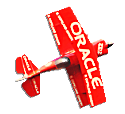
Glenluce and Galloway Flyers
landing in a cross wind

Depending on the model and the strength of the wind, this is the tricky bit! More
highly loaded models are easier as long as you keep a bit of extra speed on in
your approach and don’t try to slow it up too much. If you come in at your
normal landing speed, you run an increased risk of a tip stall with disastrous
consequences. I’ve seen this happen way too often. You must also remember to
keep enough airspeed on as you make your last turn in to line up with the
runway otherwise again you run the risk of flicking out in a tip stall that will be all
over before you can do anything about it.
In a crosswind landing use little or no flap and be prepared for a longer and
faster run out than normal.
If you are trying to land a slow, lightly loaded model, allow it to yaw as much as
you can to get a bit of bite into the wind. WW1 biplanes, vintage models and
small foam electric models can be made to crab in very slowly, but don’t slow up
too much otherwise they can just drop out of the air or flick over in an instant.
As soon as they are on the ground, use rudder to turn them directly into wind
and reduce throttle to idle.
You need to keep “flying” such models even when they are on the ground to
prevent them ground looping round or tipping over. Do this until a helper is able
to approach from behind the model and secure it for you.
I’ve seen many models burst undercarriages in crosswinds because there was
too much side stress on them as soon as they touched down whilst still yawing
sideways. You need to be ready on the rudder and ailerons to turn into the wind
a bit to take the pressure off the U.C. when you touch down.
Make sure you turn the model into wind to stop it lifting a wing tip and being
blown over.
A good way to learn these skills is to gradually practise in milder crosswind
situations to learn what the model does and how it behaves differently. In time
you will be able to increase your level of challenge as your experience and skills
grow until the point where you are comfortable with even a full 90 degree gusty
crosswind.
I would always advocate getting to know your model’s flying characteristics
very well before you attempt to take off, fly and land in crosswind conditions.
Ally Young

landing in a cross wind
Depending on the model and the strength
of the wind, this is the tricky bit! More
highly loaded models are easier as long
as you keep a bit of extra speed on in
your approach and don’t try to slow it up
too much. If you come in at your normal
landing speed, you run an increased risk
of a tip stall with disastrous
consequences. I’ve seen this happen way
too often. You must also remember to
keep enough airspeed on as you make
your last turn in to line up with the
runway otherwise again you run the risk
of flicking out in a tip stall that will be all
over before you can do anything about it.
In a crosswind landing use little or no
flap and be prepared for a longer and
faster run out than normal.
If you are trying to land a slow, lightly
loaded model, allow it to yaw as much as
you can to get a bit of bite into the wind.
WW1 biplanes, vintage models and small
foam electric models can be made to crab
in very slowly, but don’t slow up too much
otherwise they can just drop out of the air
or flick over in an instant.
As soon as they are on the ground, use
rudder to turn them directly into wind
and reduce throttle to idle.
You need to keep “flying” such models
even when they are on the ground to
prevent them ground looping round or
tipping over. Do this until a helper is able
to approach from behind the model and
secure it for you.
I’ve seen many models burst
undercarriages in crosswinds because
there was too much side stress on them
as soon as they touched down whilst still
yawing sideways. You need to be ready on
the rudder and ailerons to turn into the
wind a bit to take the pressure off the U.C.
when you touch down.
Make sure you turn the model into
wind to stop it lifting a wing tip and being
blown over.
A good way to learn these skills is to
gradually practise in milder crosswind
situations to learn what the model does
and how it behaves differently. In time
you will be able to increase your level of
challenge as your experience and skills
grow until the point where you are
comfortable with even a full 90 degree
gusty crosswind.
I would always advocate getting to
know your model’s flying characteristics
very well before you attempt to take off,
fly and land in crosswind conditions.
Ally Young

Glenluce and Galloway Flyers



